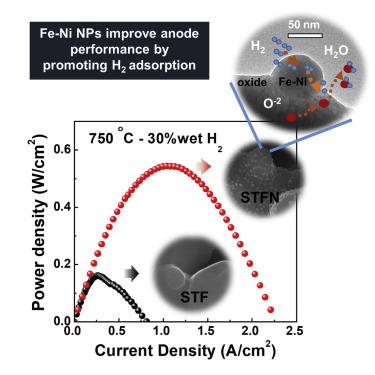Joule ( IF 38.6 ) Pub Date : 2018-02-28 , DOI: 10.1016/j.joule.2018.02.006 Tenglong Zhu , Horacio E. Troiani , Liliana V. Mogni , Minfang Han , Scott A. Barnett

|
Electrically conducting oxides have been proposed as alternatives to Ni-based cermet anodes for solid oxide fuel cells (SOFCs) to overcome issues such as coking and impurity poisoning, but their electrochemical performance is typically inferior to that of Ni-based cermets. Here we show that a new oxide composition, Sr0.95(Ti0.3Fe0.63Ni0.07)O3−δ, yields anode polarization resistance competitive with Ni cermets, and substantially better than that of the corresponding Ni-free compound, SrTi0.3Fe0.7O3−δ. Exposure to fuel results in exsolution and nucleation of Ni0.5Fe0.5 nanoparticles uniformly dispersed on the Ni-substituted perovskite surface, whereas no nanoparticles are observed on SrTi0.3Fe0.7O3−δ. A general thermodynamic model is developed that quantitatively predicts exsolved nanoparticle composition. The reduction in anode polarization resistance by the nanoparticles, by as much as 4 times, is most pronounced at cell operating temperatures below 800°C and low H2 partial pressures, suggesting that the nanoparticles improve performance by promoting H2 adsorption.
中文翻译:

镍取代的Sr(Ti,Fe)O 3 SOFC阳极:通过金属合金纳米粒子的萃取获得高性能
已经提出了导电氧化物作为用于固体氧化物燃料电池(SOFC)的镍基金属陶瓷阳极的替代品,以克服诸如焦化和杂质中毒的问题,但是它们的电化学性能通常不如镍基金属陶瓷。在这里,我们显示了一种新的氧化物成分Sr 0.95(Ti 0.3 Fe 0.63 Ni 0.07)O3 -δ,其阳极极化电阻可与Ni金属陶瓷竞争,并且明显优于相应的无镍化合物SrTi 0.3 Fe 0.7 O 3−δ。暴露于燃料中会导致Ni 0.5 Fe 0.5析出并成核纳米粒子均匀地分散在Ni取代的钙钛矿表面上,而在SrTi 0.3 Fe 0.7 O3 -δ上未观察到纳米粒子。建立了通用的热力学模型,该模型定量预测了溶解的纳米颗粒的组成。在低于800°C的电池工作温度和低H 2分压的情况下,纳米粒子将阳极极化电阻降低多达4倍,这最明显,这表明纳米粒子通过促进H 2吸附来提高性能。










































 京公网安备 11010802027423号
京公网安备 11010802027423号